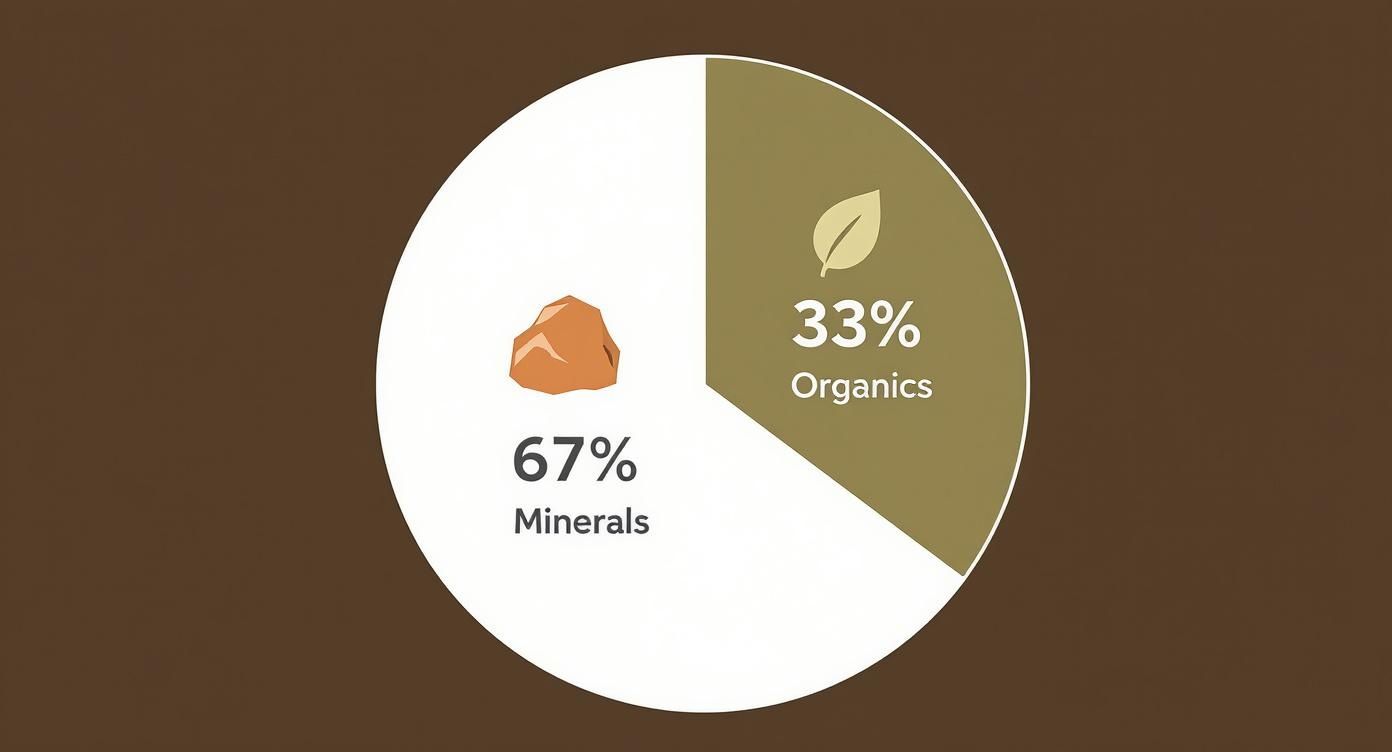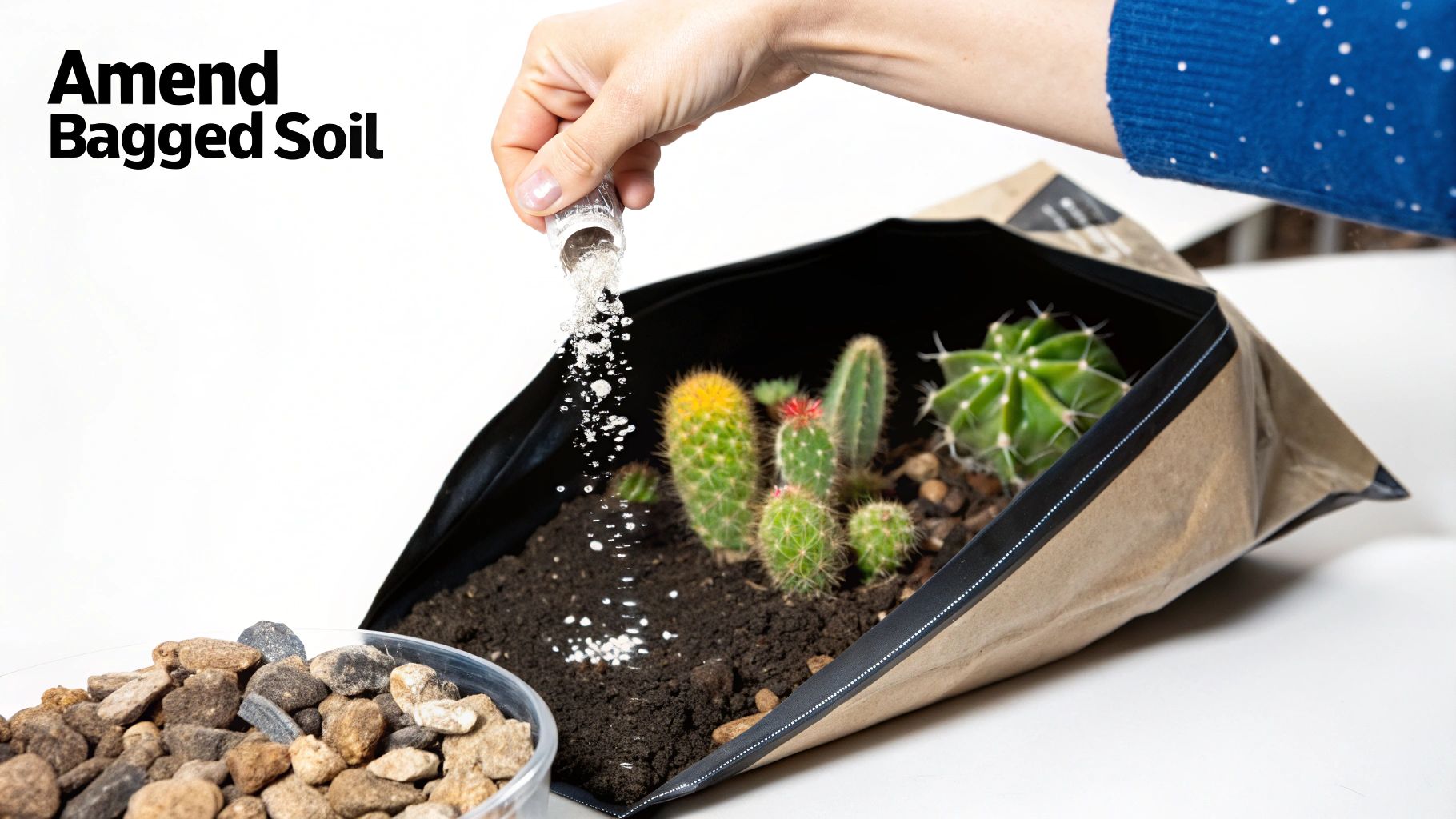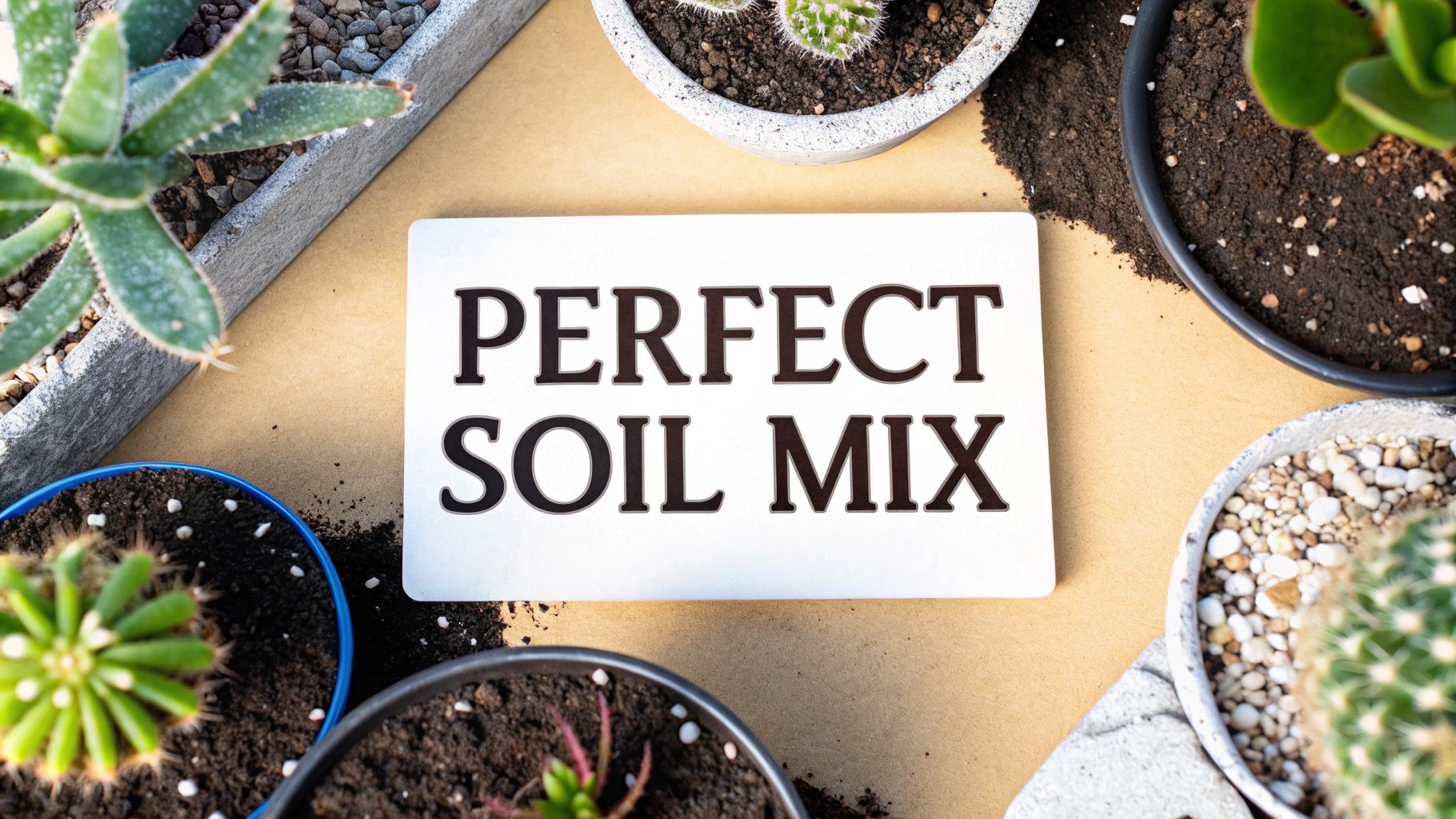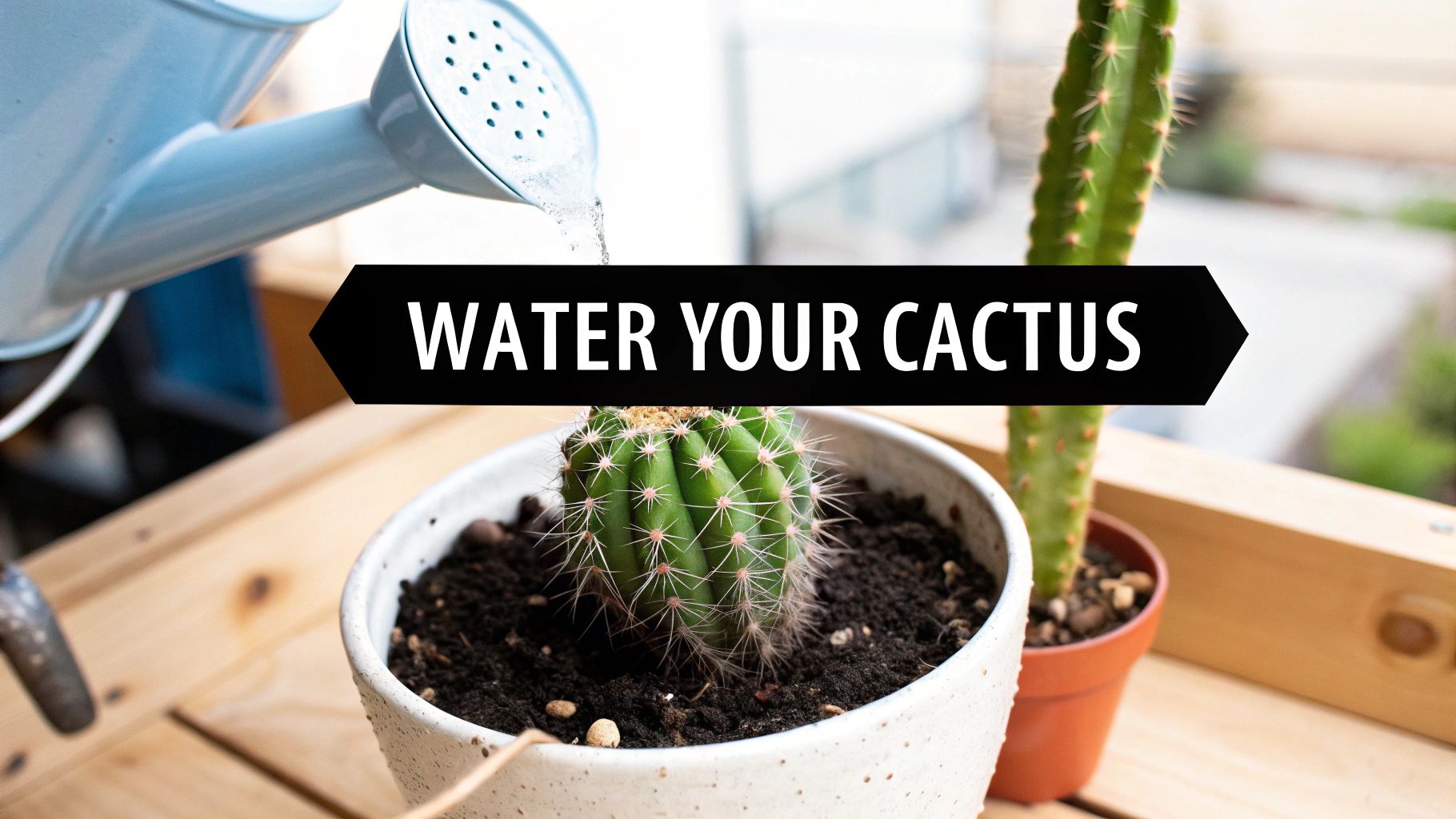If you've ever tried to grow a succulent in standard potting soil, you probably learned a hard lesson. Using a generic mix is one of the fastest ways to kill a desert plant, and the main culprit is almost always root rot. A proper cactus and succulent soil mix is built for one thing above all else: excellent drainage and aeration. This is the complete opposite of moisture-retaining soils designed for tropical houseplants.
Why Generic Potting Soil Is a Death Sentence
Let's be blunt: that bag of all-purpose potting soil is a no-go for your cacti and succulents. It's a critical mistake. These plants evolved in arid, gritty environments where rain is rare and the soil drains in an instant. Their roots are adapted to quickly soak up any available water and then dry out just as fast.

When you put them in a conventional potting mix, you're essentially drowning them. These standard soils are packed with organic materials like peat moss, which act like a sponge and hold onto water for far too long. This constant dampness suffocates the roots, cutting off vital oxygen and creating the perfect environment for the fungal pathogens that cause root rot.
The Anatomy of a Bad Mix
So what makes regular soil so dangerous for these plants? It really comes down to two major flaws:
- Poor Drainage: The fine particles and heavy organic matter get compacted easily, which traps water and creates a soggy mess around the roots.
- Lack of Aeration: When soil is compacted and wet, there are no air pockets left. Roots need to breathe, and without that oxygen, they can't function.
The tragic result is a plant that looks thirsty—its leaves might even get wrinkly—because its rotting roots can no longer absorb water. A well-meaning plant owner sees this and waters it even more, which just accelerates the death spiral.
A proper cactus and succulent soil mix isn't just a "nice-to-have"; it's non-negotiable for their survival. The whole point is to mimic their gritty, natural habitat, not a lush, water-logged garden.
It's no surprise that getting the soil right is so important, given how popular these plants have become. The global market for succulents and cacti was valued at around $3 billion USD and is expected to climb to an estimated $4.5 billion USD in the next five years. This boom is fueled by their low-maintenance reputation and social media appeal. You can discover more market insights about this growing industry.
What Makes an Ideal Succulent Soil Mix
A great soil mix for cacti and succulents is a balancing act. It needs to offer just enough nutrients to support growth but prioritize drainage above all else. This is achieved by combining organic and inorganic ingredients, with each piece of the puzzle playing a specific role.
For a mix to be successful, it needs to have a few key characteristics. This table breaks down what you're aiming for.
Essential Characteristics of an Ideal Succulent Soil Mix
| Characteristic | Why It Matters | Key Ingredients That Provide It |
|---|---|---|
| Excellent Drainage | This is the most crucial factor. It stops water from pooling around the roots, preventing rot before it can start. | Pumice, Perlite, Coarse Sand, Lava Rock |
| Proper Aeration | Creates tiny air pockets throughout the soil, allowing roots to breathe and stay healthy. Without air, roots suffocate. | Pumice, Pine Bark Fines, Perlite |
| Low Water Retention | The goal is for the soil to dry out completely between waterings, just like it would in the desert. | All inorganic materials; very limited organic matter |
| Nutrient-Poor | Succulents are used to lean soils. Too much fertilizer or rich compost can cause weak, stretched-out (etiolated) growth. | A small amount of compost or coconut coir |
Ultimately, getting these elements right means you're creating a home where your succulent can thrive, not just survive.
Getting to Know Your Soil Ingredients
Think of mixing your own cactus and succulent soil like being a baker who knows exactly what each ingredient does. Once you understand the purpose behind the flour, the sugar, and the leavening, you can go off-recipe and start creating your own masterpieces. It’s the same with soil. Knowing why you’re adding pumice or coir empowers you to tweak your mix for any plant, in any environment.
A great mix really boils down to balancing two things: gritty inorganic materials for drainage and a touch of organic matter for substance.
Most growers I know, myself included, lean heavily on the mineral side of things. A widely used and very successful ratio is about two parts mineral material to one part organic. In practice, this means minerals often make up around 67% of the total volume, which is key to replicating the lean, airy soils these plants evolved in. It's a formula that just works.
The Gritty Workhorses: Inorganic Components
These are the mineral-based materials that give your soil the structure, drainage, and aeration your succulents are desperate for. They don't break down, which means your mix stays loose and airy for years to come.
-
Pumice: This is the undisputed king for most of us who grow succulents seriously. It’s a lightweight volcanic rock absolutely riddled with tiny pores. These create fantastic air pockets in the soil. Pumice also has just enough weight to it to help anchor your plants, keeping top-heavy cacti from toppling over. While it holds a tiny bit of moisture in those pores, its main job is to provide world-class drainage.
-
Perlite: You’ve probably seen this—it looks like tiny white styrofoam balls. Perlite is a volcanic glass that’s exceptionally light, making it great for aeration. It's also usually cheaper and easier to find than pumice. The only real downside is that it’s so lightweight it often floats to the top of the pot when you water.
-
Coarse Sand: Be careful with this one. When we talk about sand, we mean coarse, gritty horticultural sand, not the fine stuff from a beach or a kid’s sandbox. Fine sand will compact and turn into a solid, cement-like block around your plant’s roots. Coarse sand helps with drainage, but it’s heavy. Honestly, I almost always reach for pumice or perlite instead because they’re far more foolproof.
-
Other Gritty Materials: You might also run into things like crushed granite, lava rock, or turface. They all do the same thing: create air gaps, fight compaction, and make sure water rushes right past the roots.
The goal with inorganic ingredients is simple: create a loose, chunky texture that prevents water from ever sitting around the roots. Think of it as building a microscopic gravel pit within your pot.
The Organic Binders: A Little Goes a Long Way
While succulents are tough, they still benefit from a little bit of organic material. This part of the mix holds onto a small amount of moisture and nutrients that roots can access between waterings.
Getting this component right is critical. Too much organic matter is the number one cause of root rot.
-
Coconut Coir: This is my go-to organic amendment. It’s made from shredded coconut husks and has a wonderful, fibrous texture that resists compaction. Coir holds on to some moisture but doesn’t get soggy and waterlogged the way peat moss can. Plus, if it dries out completely, it re-wets easily.
-
Pine Bark Fines: Tiny, shredded pieces of pine bark are another great option. They add structure and a slight acidity to the mix, which many cacti actually prefer. Their irregular shape is great for creating air pockets, and they break down very, very slowly.
-
Compost or Worm Castings: A small handful of well-sifted compost or worm castings can provide a gentle, slow-release source of food. Use them sparingly! Too much will make your soil too rich and moisture-retentive. They’re a great supplement, but shouldn't replace a proper feeding routine. If you want to learn more about feeding, check out our guide on the best fertilizer for succulents.
Once you really get a feel for what pumice, coir, and the other ingredients bring to the table, you’re no longer just following a recipe. You’re creating a custom cactus and succulent soil mix that's a perfect match for your plants and your home.
Three Proven DIY Gritty Mix Recipes
Getting your hands dirty and mixing your own soil is one of the most satisfying parts of growing cacti and succulents. Honestly, it's a game-changer. You get total control over the environment your plants live in, and I'm going to share three of my go-to recipes, tweaked and perfected over years of growing everything from simple Echeverias to really finicky desert species.
Each recipe uses the idea of "parts" to keep things simple. A "part" isn't a specific measurement like a cup or a gallon; it's just a consistent scoop. It could be an old yogurt container or a big bucket—as long as you use the same one for every ingredient in a single batch, you can scale your mix up or down without any complicated math.
We're aiming for a mix that's heavy on the mineral side for drainage, which is exactly what these plants crave.

As you can see, the ideal mix is about two-thirds inorganic (the rocks and grit) and only one-third organic. This structure is key to preventing root rot and keeping your plants happy.
Simple Starter Mix For Beginners
If you're just dipping your toes into making your own soil, start here. This recipe is foolproof and uses three basic ingredients you can find at nearly any garden center. It’s a fantastic all-purpose blend that works beautifully for the vast majority of common succulents, like Sedums, Graptopetalums, and most Echeverias.
The Recipe:
- 1 Part Pumice or Perlite: This is the heart of your drainage. I lean towards pumice because it has a little more weight and helps keep pots from tipping over, but perlite works just as well and is often easier on the wallet.
- 1 Part Coconut Coir: Coir provides a bit of structure and holds just enough moisture without turning into a swamp like peat moss sometimes can.
- 1 Part Coarse Sand: Make sure you get coarse horticultural sand. Play sand or beach sand is way too fine; it'll compact like concrete and suffocate the roots.
To mix it, just dump everything into a big bucket or onto a tarp and blend it until the texture and color look even throughout. I like to spritz it with a little water to keep the dust down. This simple 1:1:1 ratio is a huge leap in quality from typical bagged potting soils.
Pro-Grade Gritty Mix For Desert Species
When you're dealing with more sensitive plants—especially true desert cacti like Ariocarpus or Astrophytum—you need a mix that’s almost entirely mineral. These plants have zero tolerance for "wet feet." This recipe drastically cuts back on organic material to create an incredibly lean, airy environment that dries out fast, just like their native rocky homes.
The Recipe:
- 3 Parts Pumice: This is the backbone of the mix, creating tons of air pockets for the roots to breathe.
- 1 Part Lava Rock (Scoria): The rough, porous texture of lava rock adds fantastic structural integrity and more pathways for water to escape.
- 1 Part Coconut Coir: We're only adding a tiny bit here. It's just enough to hold a minimal amount of moisture and nutrients for the roots to grab onto between waterings.
This professional-level mix is all about one thing: preventing root rot in the most sensitive species. It’s lean, gritty, and incredibly forgiving if you have a heavy watering hand.
You'll notice this blend feels much heavier and rockier than the starter mix. That’s a good thing! It's the perfect choice for growers in humid climates or anyone who's struggled with overwatering in the past.
Sustainable Coir-Based Blend
For those of us trying to be more eco-conscious, this recipe avoids peat moss completely and relies on renewable resources. It’s a well-balanced, general-purpose blend that’s a little richer than the others, making it great for a wide range of succulents, from leafy Aeoniums to tough Aloes.
The Recipe:
- 2 Parts Coconut Coir: This forms the base, giving the mix great structure and moisture regulation.
- 2 Parts Pumice: The pumice keeps the coir from compacting over time and guarantees the mix stays light and aerated.
- 1 Part Pine Bark Fines: I love adding pine bark. It introduces a different texture, creates more air pockets, and breaks down very slowly.
- 1 Part Worm Castings: This is the secret ingredient. Worm castings provide a fantastic, gentle source of slow-release micronutrients and introduce beneficial microbes to the soil.
Mixing And Using Your DIY Soil
No matter which recipe you go with, the process is the same. I usually mix a huge batch on a tarp in the garage so I always have some on hand for new plants or repotting projects.
- Get Your Gear. Grab your ingredients and whatever you've chosen for your "part" (a pot, a scoop, etc.).
- Combine and Blend. Dump everything onto your tarp or into a large mixing tub. Use a trowel or just your hands (with gloves!) to mix it all together until it’s totally uniform.
- Lightly Dampen. Add just a splash of water and mix again. You're aiming for slightly damp, not wet. This cuts down on dust and makes potting much cleaner.
- Store The Extra. Shovel any leftover mix into a lidded container, like a storage tote or a 5-gallon bucket, to keep it clean and ready for next time.
Trust me, learning to make your own succulent soil puts you in the driver's seat. You'll be able to create the absolute perfect growing medium for any plant you bring home.
Customizing Your Soil for Plant Type and Climate
Once you’ve got a handle on a good, basic cactus and succulent soil mix, you’ll start to see it for what it is: a fantastic starting point. But it’s not the final word. There’s simply no universal recipe that’s perfect for every single plant in every home on the planet.
The real art of growing these plants well is learning how to tweak that base recipe. It all comes down to two things: the specific plant you’re growing and the climate it's living in.
Think about it. A delicate, leafy Echeveria sitting in a humid Florida apartment needs something very different from a tough barrel cactus baking on a sun-drenched California patio. The Echeveria is a prime candidate for rot if its feet stay wet, while the cactus could use a bit more water retention to survive the intense heat. This is where you move beyond just following instructions and start to really understand your plants.
Reading Your Plant's Needs
Different succulents have different tastes in soil, and it usually ties back to where they originally grew in the wild. Some are thirstier, and some demand drainage so sharp you’d think they were allergic to water. Your job is to become a bit of a plant detective.
Take succulents with those fat, plump leaves—think of most Sedum or Graptopetalum species. They are basically little living water balloons. Because they store so much moisture in their leaves, they are incredibly sensitive to overwatering. For these guys, you’ll want to lean heavily into a grittier mix, upping the amount of pumice or lava rock to make sure that soil dries out fast.
Now, flip the script and consider plants like Senecio rowleyanus (String of Pearls) or other thin-leafed varieties like some Kalanchoes. They can’t bank nearly as much water, so they often do better in a mix that holds moisture for just a little bit longer. For them, you might slightly increase the coconut coir or even add a small scoop of compost to your base mix. That tiny change gives their finer roots enough time to take a good drink before everything is bone-dry again.
The goal is always to create a soil environment that mimics what the plant would experience in its natural habitat. Picture where it comes from—a rocky, windswept cliff or a slightly richer desert floor—and adjust your mix to match that picture.
Adjusting Your Mix for Your Climate
Where you live plays a huge role in how fast your pots dry. A mix that works wonders for a grower in dry, arid Arizona could easily be a death sentence for the same plant in rainy, damp Seattle. This is a critical factor to consider, especially if you're thinking about growing succulents outdoors where they're at the mercy of the weather.
Let’s walk through a couple of real-world examples.
-
Hot, Dry Climates (like Arizona or inland California): Here, intense sun and low humidity mean soil dries out at lightning speed, especially in classic terracotta pots. A standard gritty mix might actually dry too fast, stressing the plant out. The fix is simple: bump up the organic component. Instead of a 2:1 mineral-to-organic ratio, you might shift to 3:2. That little bit of extra coir or compost adds just enough water retention to see the plant through the hottest days without turning into a swamp.
-
Humid or Rainy Climates (like the Pacific Northwest or the Southeast): In these places, the air is already heavy with moisture, and frequent rain is a given. Your number one enemy is rot. To fight back, you have to go in the complete opposite direction and make your mix even more gritty. I’d recommend significantly increasing the pumice or perlite. You might even want to add chunkier materials like lava rock or horticultural charcoal to create air pockets and ensure the soil can dry out, even during a soggy week.
I've put together a quick-reference table to help you visualize some common adjustments you might need to make.
Soil Mix Adjustments for Common Scenarios
This table breaks down how you can tweak your base soil recipe for different plants and environmental conditions.
| Scenario / Plant Type | Recommended Adjustment | Reasoning |
|---|---|---|
| Plump-leafed Succulents (Echeveria, Sedum) | Increase pumice/perlite content by 10-15%. | These plants store ample water in their leaves and are highly susceptible to root rot if soil stays wet. |
| Desert Cacti (Ariocarpus, Astrophytum) | Use a nearly all-mineral mix (80-90% grit). | These species come from extremely arid regions and require exceptionally sharp drainage to prevent rot. |
| 'Thirsty' Succulents (Senecio, Aeonium) | Increase coconut coir or add compost by 10%. | Their finer roots and thinner leaves mean they appreciate slightly more moisture retention than desert species. |
| Hot, Dry Outdoor Climate | Slightly increase the organic component. | Helps the soil retain just enough moisture to prevent the plant from drying out too quickly under intense sun. |
| Humid or Rainy Climate | Drastically increase the inorganic component. | Maximizes drainage and aeration to counteract high ambient humidity and prevent fungal issues and rot. |
By learning to really look at your plants and pay attention to your environment, you’ll graduate from following recipes to truly understanding the principles of a great cactus and succulent soil mix. Honestly, that's the skill that separates the good growers from the great ones.
Taking a Closer Look at Store-Bought Cactus Soil
Let's be real—not everyone has the time, space, or desire to mix up a big batch of their own soil. Sometimes, you just need to pot up a new plant or two, and grabbing a pre-made bag is just plain easier. And with the houseplant hobby exploding, you’ll likely find several options on the shelf at your local garden center.

This boom in container gardening is serious business. The global market for potting soil was valued at around USD 2.5 billion and is expected to climb to USD 3.6 billion. You can dig into the latest potting soil market trends to see just how much our collective love for plants has grown. More popularity means more choices on the shelves, but unfortunately, not all of them are good for our plants.
How to Read the Bag Like an Expert
So, how do you pick a winner? It starts with learning to read the clues on the bag and even through the bag. A quick inspection can tell you almost everything you need to know.
What You Want to See (Green Flags):
- Visible Grit: You should be able to see or feel bits of inorganic material like pumice, perlite, or lava rock.
- A Lightweight Bag: A good mix should feel surprisingly light for its volume. This signals plenty of aeration and not a lot of heavy, water-retaining gunk.
- Coarse Ingredients: The ingredients list should feature things like pine bark fines or coconut coir instead of being dominated by peat moss.
What to Avoid (Red Flags):
- Peat Moss is #1: Cheaper mixes are often almost entirely peat moss, which is a recipe for dense, waterlogged soil and root rot.
- Vague "Forest Products": This often means fine wood chips that compact over time and can hold too much moisture.
- Heavy and Spongy: If the bag feels heavy and dense like a wet sponge, leave it on the shelf. Your cactus roots will thank you.
A great store-bought mix should look and feel more like gravel with a little bit of soil in it, not the other way around. If it just looks like regular potting soil, it won't give your succulents the sharp drainage they desperately need.
My Go-To Trick for Improving Any Bagged Soil
Here’s a little secret that experienced growers have been using for years: always amend your store-bought soil. Even the best commercial mixes can be made better with one simple addition, giving you the perfect blend of convenience and quality.
To turn a so-so bag of soil into a fantastic growing medium, just mix it with an equal amount of pumice or perlite.
That simple 1:1 ratio—one part cactus mix to one part pumice—instantly doubles the aeration and drastically improves drainage. It's a nearly foolproof method for giving your plants the airy root zone they crave. When you're out shopping for amendments, you might also look at a professionally formulated cactus and succulent growers soil to get a feel for what a truly top-tier blend looks like. With this one easy step, you give your plants a much better start in life without the mess of sourcing a dozen different ingredients.
Common Questions About Succulent Soil
Even with the best recipes in hand, some questions always pop up when you're elbow-deep in a fresh batch of cactus and succulent soil mix. These are the nitty-gritty, practical things I hear all the time from other growers. Honestly, getting these details right is often the difference between a plant that just hangs on and one that really thrives.
Let's dig into some of the most common questions and clear things up.
How Often Should I Change My Succulent Soil?
This is a great question because it’s all about long-term plant health. Mixing soil isn't just a one-and-done task.
As a general rule of thumb, you’ll want to repot your cacti and succulents with fresh soil every 2-3 years. What happens over time is that even the best soil mix starts to break down. The organic bits—the coconut coir or bark—slowly decompose and get compacted.
This compaction is the number one enemy of healthy roots. It squeezes out all the crucial air pockets, which kills aeration and slows drainage to a crawl. In short, your perfectly fluffy soil slowly turns back into the dense, water-logged mud you were trying to avoid in the first place.
Repotting every couple of years does a few critical things for your plant:
- Restores Structure: It brings back that light, airy, fast-draining texture roots love.
- Replenishes Nutrients: It gives the plant a small boost of fresh trace nutrients from the new organic matter.
- Allows for a Health Check: It's the perfect opportunity to get a look at the root system and check for any signs of pests or rot.
Can I Reuse Old Succulent Soil?
This one usually comes right after the last question. And while I get the temptation to save a few bucks by reusing old soil, I almost always advise against it.
For one, old soil can be a hiding place for pests and diseases that could easily infect your new, healthy plant. But more importantly, as we just covered, that soil has likely lost its structure. Its ability to drain water and hold air is a fraction of what it once was, putting your plant at a much higher risk of root rot right from the start.
Think of it this way: You wouldn't put a high-performance engine in your car and then fill it with old, sludgy oil. Give your plants the fresh start they deserve with a new batch of soil.
The only time I'd even consider it is if the soil is less than a year old and the plant that was in it was in perfect health. Even then, it's a gamble. I'd much rather toss old, disease-free soil into my outdoor compost pile than put it back into a pot with a new plant.
Is Sand a Good Addition to My DIY Mix?
This is one of the most stubborn myths in the succulent world, and it can cause real disasters if you get it wrong. The answer is a very hesitant "maybe," but for most people, it should be a hard "no."
It all comes down to the type of sand. You should never, ever use fine sand—like the stuff you’d find in a kid’s sandbox or at the beach. When it gets wet, those tiny particles lock together and compact into a dense, concrete-like brick that stops water and air dead in their tracks. It does the exact opposite of what you want.
If you insist on using sand, it absolutely has to be a coarse, gritty horticultural sand. The larger particles do help create space and improve drainage. Personally, though, I find pumice and perlite are way more effective and much more foolproof for getting that light, airy soil you're after. If you're just starting out, stick with pumice—it's the safer bet.
My Gritty Mix Dries Out Instantly. What Should I Do?
Ha! Sometimes you can do too good of a job creating drainage. If you find your soil is bone-dry just a day or two after a deep watering, your mix is probably a little too gritty for your plant or your specific environment. I see this a lot with plants in small terracotta pots or with growers who live in really hot, dry climates.
Thankfully, the fix is simple: you just need to dial up the organic component a tiny bit.
Try mixing in a small amount of extra coconut coir or sifted compost. This tweak helps the soil hold onto a bit more moisture for a little longer, but without ever getting soggy. It’s all about finding that sweet spot for your unique growing conditions.
At The Cactus Outlet, we live and breathe these incredible plants. We know that starting with the right foundation is the key to a lifetime of enjoyment. Explore our massive collection of healthy, beautiful cacti and succulents today. Visit us at https://www.cactusoutlet.com and find the perfect desert gem to bring home.




